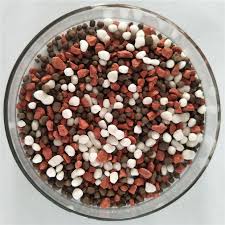
सितम्बर . 14, 2024 15:31 Back to list
best 5-0-15 fertilizer
Understanding Best 5-0-15 Fertilizer A Comprehensive Guide
Fertilizers play a crucial role in modern agriculture and gardening, providing essential nutrients that plants require for healthy growth and development. Among the variety of fertilizers available, the 5-0-15 formulation stands out for specific applications, primarily in boosting flowering and fruiting stages of plant growth. In this article, we will delve into the significance of the 5-0-15 fertilizer, its components, application methods, and benefits.
What Does 5-0-15 Mean?
The numbers in the fertilizer label represent the N-P-K ratio, which indicates the percentage by weight of nitrogen (N), phosphorus (P), and potassium (K) respectively. For 5-0-15 fertilizer, it contains
- 5% Nitrogen (N) Essential for vegetative growth, nitrogen is vital for the synthesis of proteins and chlorophyll. However, the relatively lower percentage in this formulation suggests that nitrogen is not the primary focus, making it suitable for plants in later stages of development.
- 0% Phosphorus (P) This fertilizer does not provide phosphorus, which is crucial during early plant growth stages for root development. Therefore, it is not recommended for young or newly planted crops that require phosphorus for establishing themselves.
- 15% Potassium (K) Potassium is key for flowering, fruiting, and overall plant health. It aids in photosynthesis, water regulation, and the synthesis of carbohydrates. The high concentration of potassium in this fertilizer makes it particularly effective for fruit-bearing plants and flowering crops.
When to Use 5-0-15 Fertilizer
Given its specific nutrient composition, 5-0-15 fertilizer is best applied during the flowering and fruiting stages of plant growth. For example, if you're growing tomatoes, peppers, or flowering annuals, applying this fertilizer can enhance fruit set and improve overall yields. Using it at the right time can lead to vibrant flowers and robust fruit development, maximizing your garden's productivity.
Application Methods
best 5-0-15 fertilizer

When applying 5-0-15 fertilizer, it’s important to follow the recommended guidelines for your specific plants. Here are some general tips
1. Soil Preparation Before planting, ensure that the soil is well-prepared. This includes testing soil pH and nutrient levels to determine the exact needs of your crops.
2. Broadcasting For established plants, you can broadcast the fertilizer around the base of the plant, keeping it away from the stem to avoid root burn.
3. Watering After application, water the area thoroughly. This helps the nutrients penetrate the soil and reach the plant roots effectively.
4. Foliar Feeding In some cases, 5-0-15 fertilizer can be used as a foliar feed, where a diluted solution is sprayed directly onto the leaves. This method allows for rapid nutrient uptake.
Benefits of 5-0-15 Fertilizer
The primary benefits of using 5-0-15 fertilizer include
- Enhanced Root Development Although it has no phosphorus, the other nutrients can still support robust root systems during active growth. - Improved Flower and Fruit Production The high potassium content promotes flowering and fruit set, leading to higher yields.
- Balanced Plant Health The presence of nitrogen, albeit in lower amounts, combined with potassium sustains plant health, vigor, and resistance to stress.
In conclusion, 5-0-15 fertilizer is an excellent choice for gardeners and farmers looking to enhance flowering and fruiting in their crops. However, it’s essential to understand its specific nutrient profile and application timing to maximize its effectiveness. By integrating this fertilizer into your gardening practices, you can enjoy a bountiful and vibrant harvest.
-
Premium 8 12 16 Fertilizer – High-Efficiency Compound & Granular NPK Supplier
NewsJun.10,2025
-
High Quality Agricultural Grade NPK Fertilizer Manufacturer & Supplier Reliable Factory Price
NewsJun.10,2025
-
Organic Fertilizer for Corn Boost Yield Sustainably
NewsJun.10,2025
-
Organic Fertilizer for New Plants Natural Growth Boost & Eco Nutrients
NewsJun.10,2025
-
Optimized Hydroponic NPK Fertilizer – Fast Growth & Nutrients
NewsJun.09,2025
-
Top-Rated NPK Fertilizer for Fruit Trees - Boost Growth & Yield
NewsJun.09,2025
